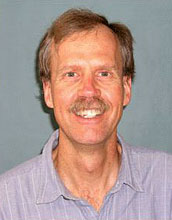News Release 10-020
NSF Announces the Appointment of James Ulvestad as the New Director of its Division of Astronomical Sciences
Deemed a leader in the astronomy community, NRAO assistant director to start at NSF March 1, 2010

James S. Ulvestad will serve as NSF's new director of the Division of Astronomical Sciences.
February 1, 2010
This material is available primarily for archival purposes. Telephone numbers or other contact information may be out of date; please see current contact information at media contacts.
NSF is pleased to announce the appointment of James S. Ulvestad as division director for Astronomical Sciences in the mathematical and physical sciences (MPS) directorate, effective March 1, 2010.
Ulvestad comes to the NSF from the U.S. National Radio Astronomy Observatory (NRAO), where he has been an assistant director since 2001. Since 2006, he has been head of the NRAO New Initiatives Office. From 2001 through 2007, he was head of New Mexico Operations, including the NSF Very Large Array and Very Long Baseline Array radio telescopes. Prior to his arrival at NRAO in 1996, Ulvestad spent 12 years on the technical staff at the NASA Jet Propulsion Laboratory.
"I'm sure I can speak for the division, the directorate, and the community when I say how delighted we are that Jim has agreed to serve in this critical leadership role for astronomical research," said Ed Seidel, acting assistant director for NSF's MPS directorate, "We are looking forward to having him as a colleague and working with him and the astronomical community in the advancement of the mathematical and physical sciences."
Ulvestad received his Bachelor of Arts degree in astronomy from the University of California at Los Angeles in 1976, and his Ph.D. in astronomy from the University of Maryland in 1981. His research interests focus on radio interferometric imaging of active galactic nuclei in order to study the process of accretion on massive black holes. In addition, he studies the populations of supernova remnants and massive star formation in nearby starburst galaxies. In 1986, he was a member of the first team to demonstrate the scientific capability of high-resolution radio imaging by combining radio telescopes on Earth with an orbiting radio telescope; he also was a key member of the team that used the Very Large Array for telemetry reception from the Voyager 2 spacecraft when it encountered Neptune in 1989.
Ulvestad served on the American Astronomical Society (AAS) Council from 2005 through 2008, and has been a member of the AAS Committee on the Status of Women in Astronomy as well as the Committee on Astronomy and Public Policy. In recent years, he served on the NASA Structure and Evolution of the Universe Subcommittee as well as the National Research Council's Beyond Einstein Program Assessment Committee. Ulvestad is just completing a term as chair of the Demographics Study Group of the Astro2010 decadal survey in astronomy and astrophysics. He also is a recipient of five NASA Group Achievement Awards.
In a memo to staff members of the MPS directorate, Seidel thanked Ulvestad's predecessor for his leadership during the transition: "I would also like to take this opportunity to express my sincere appreciation to Dr. Craig Foltz for serving so capably as the acting division director for Astronomical Sciences from April 2008 to September 2009 and, since then, as division director for Astronomical Sciences."
-NSF-
Media Contacts
Lisa-Joy Zgorski, NSF, (703) 292-8311, email: lisajoy@nsf.gov
The U.S. National Science Foundation propels the nation forward by advancing fundamental research in all fields of science and engineering. NSF supports research and people by providing facilities, instruments and funding to support their ingenuity and sustain the U.S. as a global leader in research and innovation. With a fiscal year 2023 budget of $9.5 billion, NSF funds reach all 50 states through grants to nearly 2,000 colleges, universities and institutions. Each year, NSF receives more than 40,000 competitive proposals and makes about 11,000 new awards. Those awards include support for cooperative research with industry, Arctic and Antarctic research and operations, and U.S. participation in international scientific efforts.
Connect with us online
NSF website: nsf.gov
NSF News: nsf.gov/news
For News Media: nsf.gov/news/newsroom
Statistics: nsf.gov/statistics/
Awards database: nsf.gov/awardsearch/
Follow us on social
Twitter: twitter.com/NSF
Facebook: facebook.com/US.NSF
Instagram: instagram.com/nsfgov


